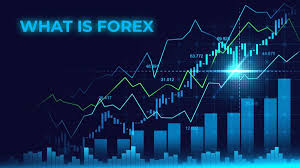What is Forex?
Forex, short for foreign exchange, refers to the global marketplace where currencies are traded. It is the largest financial market in the world, with a daily trading volume exceeding $6 trillion. Unlike other markets, the forex market operates 24 hours a day, five days a week, allowing traders to engage in transactions from anywhere in the forex candlestick chart.
How Forex Trading Works
Forex trading involves buying one currency while simultaneously selling another. Currencies are traded in pairs, such as EUR/USD (Euro/US Dollar) or GBP/JPY (British Pound/Japanese Yen). The first currency in a pair is known as the base currency, and the second is the quote currency. The exchange rate indicates how much of the quote currency is required to purchase one unit of the base currency.
For example, if the EUR/USD pair is trading at 1.20, it means that 1 Euro is equivalent to 1.20 US Dollars. Traders aim to profit from fluctuations in exchange rates, buying when they believe the value of the base currency will rise and selling when they anticipate a decline.
Key Participants in the Forex Market
- Central Banks: National banks control monetary policy and manage currency values through interest rates and interventions.
- Financial Institutions: Banks, hedge funds, and investment firms engage in forex trading for profit and to hedge against currency risks.
- Corporations: Businesses involved in international trade use forex to convert currencies for transactions, protecting against unfavorable exchange rate movements.
- Retail Traders: Individual traders can access the forex market through online platforms and brokers, using leverage to enhance their trading potential.
Types of Forex Trading Strategies
- Day Trading: Involves opening and closing positions within the same trading day, aiming to profit from short-term price movements.
- Swing Trading: Traders hold positions for several days or weeks, capitalizing on medium-term trends.
- Scalping: A high-frequency trading strategy where traders make numerous small trades throughout the day to capture tiny price movements.
- Position Trading: Long-term trading strategy where traders hold positions for weeks, months, or even years, based on fundamental analysis.
Factors Influencing Currency Prices
- Economic Indicators: Reports on GDP, employment rates, inflation, and consumer spending can influence currency values.
- Interest Rates: Central banks adjust interest rates to control inflation, which directly affects currency strength.
- Political Stability: Political events, such as elections and geopolitical tensions, can create volatility in currency markets.
- Market Sentiment: Traders’ perceptions and emotions can drive currency prices, leading to fluctuations based on news and market trends.
Risks of Forex Trading
While forex trading offers significant profit potential, it also comes with substantial risks:
- Leverage: Forex trading often involves using borrowed funds, which can amplify losses.
- Market Volatility: Sudden price movements can lead to unexpected losses, especially in uncertain market conditions.
- Lack of Regulation: The forex market is decentralized, and traders must choose reputable brokers to avoid fraud.
Conclusion
Forex trading can be an exciting and potentially lucrative venture, but it requires a solid understanding of the market, strategies, and risk management. Aspiring traders should educate themselves, practice with demo accounts, and develop a disciplined trading approach. By doing so, they can navigate the complexities of the forex market and increase their chances of success.

More Stories
The Evolution and Allure of Slot Games: From Mechanical Marvels to Digital Entertainment
The Evolution and Allure of Slot Games: From Classic Reels to Digital Thrills
The Evolution and Allure of Slot Games: From Classic Reels to Modern Digital Entertainment